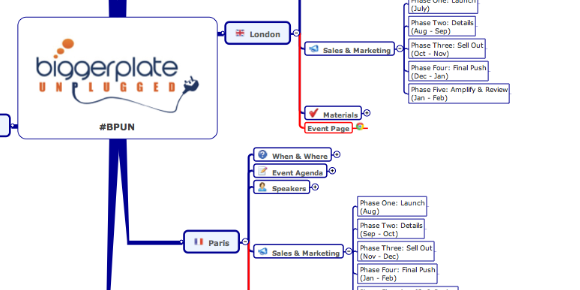 |
|
| Name: Liam Hughes | |
| Title: Founder, Biggerplate.com | |
| Started using Mindjet: 2007Social links: biggerplate, Twitter, Facebook | |
How did you hear about Mindjet?
I was introduced to Mindjet during my final year of university in 2007, when I was doing a tremendous job of enjoying my student life, but a less impressive job of studying. Facing my final exams, and with very little understanding of what I had supposedly studied over the last three years, I decided to use Mindjet to map out my course content in a last-ditch effort to pass. It worked extremely well, and it was this experience that gave me the idea to create the mind map library at Biggerplate.com.
What do you primarily use it for?
I use it for pretty much everything. From day to day task management, to website scoping, competitive analysis, right through to strategic business planning. Most recently, I’ve been using it to plan a series of mini-conference events for mind mappers, using one map as the central dashboard for all the information and ideas associated with the project. When you’re organizing five different events in five different cities around the world, the information and actions can very quickly build up, and I’m not quite sure you could manage it without a map!
Generally, I think mapping software is the must-have tool for entrepreneurs, as it has been absolutely integral to me starting, growing, and managing my business. There are very few tasks/projects in my world that do not start off with a map. Even if I then move to another format, I’ll always start with a map in order to establish some clarity around all the ideas, and a sense of the total picture at that point in time. The ability to see the ‘big picture’, but also dive into details (using features like the filters) is extremely unique. I don’t know of any other tool that enables this level of macro and micro clarity.
What is your favorite feature?
I go through phases of what I like the most… At the moment, I’m really using the export to interactive PDF a lot, as it has saved me a great deal of hassle over the last few weeks on a project, and I’m always grateful when features help me to appear vaguely competent!
One feature I really like using with groups is the brainstorm trigger cards. It’s a great addition to the software, and even the most cynical participant usually finds themselves responding to one of the triggers. The fact that such a creative and unstructured process can be channelled into a coherent map structure is extremely powerful, and the end result is always a good representation of the discussion.
Is there anything the tool helps with that was unexpected?
It’s an old example, but I actually wrote my university dissertation (10,000 words) almost entirely using Mindjet. I captured all my quotes, book sources, online references, and ideas into a research map, and had a second map which came to be the skeleton of the actual written work. I would write chunks of the essay in Mindjet, and the ability to then move them about, re-order, adapt, bring in my quotes from the research map was extremely powerful. By the end of the process, I had a map that represented a 95% finished dissertation. I exported the map to Word, did some final tidying and formatting, and hit print!
It was a really surprising use of Mindjet at the time, and I now use the same approach if I am planning and writing large proposal documents. The map format forces you to think more clearly about how you are structuring the overall piece, and the content within it. That’s extremely powerful!
Tell us about the map you’ve attached here.
The attached map is being actively used on a daily basis at Biggerplate to help with the planning and organisation of a series of conference events for mind mappers around the world. As we are a small business based in the UK, it’s a real challenge to try and keep track of all the progress and considerations for events as far afield as Paris and San Francisco! We therefore have one single map where we capture all the research (for venues, speakers, materials), as well as assign actions and timeframes. The map also acts as a directory/dashboard for accessing other information, whether that is web links, files and folders, or simply keeping notes. The map you see here has been stripped of much of the information (we have to keep some things secret), but you can still see how we have broken down this very large project into more manageable sections, in order to give us a central point from which to work and plan!
[Click for full size image]
Mind mapping library Biggerplate.com was originally launched in January 2008, and has since grown into one of the largest digital resources of its kind. Sign up (it’s free!) if you’re hankering to be a part of a very cool community or, if you’d like more info, check out their blog here.
—
Here at Mindjet, we know the value of sharing ideas. It’s just like philosopher Michel de Montaigne said way back in the 1500s: “It is good to rub and polish our brain against that of others.” The Mindjet User Spotlight series aims to help that little endeavor along by bringing your stories and experiences with Mindjet to the forefront. If you’ve got one to share, don’t be shy! Give me a shout on your communication platform of choice: @Chelsi / facebook.com/chelsi / E-mail Chelsi


